Thermal State, Thickness, and Composition of the Lithospheric Mantle beneath the Upper Muna Kimberlite Field (Siberian Craton) Constrained by Clinopyroxene Xenocrysts and Comparison with Daldyn and Mirny Fields
Abstract
1. Introduction
2. Geological Setting
3. Materials and Methods
3.1. Sample Descriptions
3.2. Analytical Methods
3.3. Mineral Thermobarometry
3.4. Computation of the Paleogeotherm
4. Results
4.1. Clinopyroxene Thermobarometry
- We discarded grains for which at least one of three electron microprobe analyses do not satisfy the quality test, i.e., total cations calculated per 6 oxygen atoms fall outside 3.98–4.02 range (Tables S2 and S3).
- Twenty-nine grains exhibited obvious compositional inhomogeneity, suggesting possible disequilibrium and were excluded from the study.
- Thus, 323 homogeneous clinopyroxene xenocrysts were selected (Tables S2 and S3). For further evaluation, we used the average of three individual analyses per grain. This reduces uncertainties proportional to the square root of three.
- We excluded 65 clinopyroxenes with low Al2O3 and MgO contents according to the following criteria: Al2O3 ≥ 0.7 wt% and Al2O3 ≥ 12.175−0.6375·MgO wt% (Table S3).
- All grains that were not excluded at previous stages satisfy the Cr# criterion, i.e., are within the 0.10–0.65 interval (Table S2).
- A further 43 grains with aCr/Cr# ≤ 0.11 were discarded (Table S3), as aCr is the main building block in the PNT00 formulation.
- Verification of clinopyroxene equilibration with orthopyroxene is difficult by means of simple compositional filters. However, it is recommended to use clinopyroxene with molar Ca/(Ca + Mg) ratio (Ca#) below 0.5 [23]. Six of the studied clinopyroxene xenocrysts have Ca# > 0.5, but they had already been excluded at previous steps.
- It is also recommended to exclude samples with temperatures below 700 °C because TNT00 is not calibrated at <700 °C. Another reason to discard these points is that low estimates of temperature may indicate that clinopyroxene was not in equilibrium with orthopyroxene. We excluded one grain at this step.
4.2. Steady-State Paleogeotherm for the Mantle Beneath the KM Pipe
4.3. Thermobarometry of Mantle Xenoliths from the Komsomolskaya-Magnitnaya Pipe
4.4. Mantle Composition for the Komsomolskaya-Magnitnaya Pipe: Constraints from Clinopyroxene Xenocrysts
4.5. Clinopyroxene Xenocrysts: Depth Distribution Profile for KM Pipe
4.6. The Mantle Paleogeotherm Beneath the Mir and Udachnaya Pipes
5. Discussion
5.1. A Mantle Paleogeotherm Beneath the Upper Muna Field
5.2. The “Kink” Problem of the Paleogeotherm in Lithosphere Mantle
5.3. Comparison of Lithospheric Thickness Beneath the Upper Muna, Daldyn, and Mirny Fields
5.4. Composition and Stratigraphy of Lithospheric Mantle Beneath the Upper Muna Field
5.5. Implication for Diamond Potential of the Siberian Kimberlites
6. Concluding Remarks
- The preferred steady-state mantle paleogeotherm was constrained by P-T estimates of selected clinopyroxene xenocrysts from the Komsomolskaya-Magnitnaya pipe, i.e., that (i) passed through the protocol proposed by Ziberna et al. [23], and (ii) showed T < 1200 °C. Clinopyroxenes with T > 1200 °C were excluded because they may represent a “kink” caused by a thermal event associated with kimberlite magmatism.
- P-T estimates for the coarse peridotites from the KM pipe are consistent with the clinopyroxene geotherm, testifying that large P-T data sets for clinopyroxene xenocrysts alone can be successfully used to constrain the robust steady-state paleogeotherm.
- Fitting of P-T data for clinopyroxenes from the KM pipe using the FITPLOT program yielded a mantle paleogeotherm similar to the nearby Novinka pipe [23]. Thus, we accept a ~34–35 mW/m2 surface heat flux, 225–230 km lithospheric thickness, and 110–120 thick “diamond window” for the Upper Muna field.
- Peridotitic clinopyroxenes are predominant (89%) among xenocrysts studied from the KM pipe, testifying that mantle beneath the Upper Muna field is mainly composed of peridotites. This is consistent with previous studies.
- The estimated lithosphere thickness beneath Upper Muna is slightly larger than for the Daldyn (218 km) and Mirny (210 km) fields. However, considering their mutual uncertainties, the lithosphere thicknesses for these three fields are similar.
Supplementary Materials
Author Contributions
Funding
Acknowledgments
Conflicts of Interest
References
- Griffin, W.L.; Kaminsky, F.V.; Ryan, C.G.; Oreilly, S.Y.; Win, T.T.; Ilupin, I.P. Thermal state and composition of the lithospheric mantle beneath the Daldyn kimberlite field, Yakutia. Tectonophysics 1996, 262, 19–33. [Google Scholar] [CrossRef]
- Griffin, W.L.; Ryan, C.G.; Kaminsky, F.V.; O’Reilly, S.Y.; Natapov, L.M.; Win, T.T.; Kinny, P.D.; Ilupin, I.P. The Siberian lithosphere traverse: Mantle terranes and the assembly of the Siberian Craton. Tectonophysics 1999, 310, 1–35. [Google Scholar] [CrossRef]
- Aulbach, S.; Griffin, W.L.; O’Reilly, S.Y.; McCandless, T.E. Genesis and evolution of the lithospheric mantle beneath the Buffalo Head Terrane, Alberta (Canada). Lithos 2004, 77, 413–451. [Google Scholar] [CrossRef]
- Agashev, A.M.; Ionov, D.A.; Pokhilenko, N.P.; Golovin, A.V.; Cherepanova, Y.; Sharygin, I.S. Metasomatism in lithospheric mantle roots: Constraints from whole-rock and mineral chemical composition of deformed peridotite xenoliths from kimberlite pipe Udachnaya. Lithos 2013, 160–161, 201–215. [Google Scholar] [CrossRef]
- Rezvukhin, D.I.; Malkovets, V.G.; Sharygin, I.S.; Tretiakova, I.G.; Griffin, W.L.; O’Reilly, S.Y. Inclusions of crichtonite-group minerals in Cr-pyropes from the Internatsionalnaya kimberlite pipe, Siberian Craton: Crystal chemistry, parageneses and relationships to mantle metasomatism. Lithos 2018, 308–309, 181–195. [Google Scholar] [CrossRef]
- McKenzie, D.; Jackson, J.; Priestley, K. Thermal structure of oceanic and continental lithosphere. Earth Planet. Sci. Lett. 2005, 233, 337–349. [Google Scholar] [CrossRef]
- Mather, K.A.; Pearson, D.G.; McKenzie, D.; Kjarsgaard, B.A.; Priestley, K. Constraints on the depth and thermal history of cratonic lithosphere from peridotite xenoliths, xenocrysts and seismology. Lithos 2011, 125, 729–742. [Google Scholar] [CrossRef]
- Griffin, W.L.; Fisher, N.I.; Friedman, J.; Ryan, C.G.; O’Reilly, S.Y. Cr-pyrope garnets in the lithospheric mantle. I. Compositional systematics and relations to tectonic setting. J. Petrol. 1999, 40, 679–704. [Google Scholar] [CrossRef]
- Kopylova, M.G.; Russell, J.K.; Cookenboo, H. Upper-mantle stratigraphy of the Slave craton, Canada: Insights into a new kimberlite province. Geology 1998, 26, 315–318. [Google Scholar] [CrossRef]
- Howarth, G.H.; Barry, P.H.; Pernet-Fisher, J.F.; Baziotis, I.P.; Pokhilenko, N.P.; Pokhilenko, L.N.; Bodnar, R.J.; Taylor, L.A.; Agashev, A.M. Superplume metasomatism: Evidence from Siberian mantle xenoliths. Lithos 2014, 184–187, 209–224. [Google Scholar] [CrossRef]
- Malkovets, V.G.; Griffin, W.L.; O’Reilly, S.Y.; Wood, B.J. Diamond, subcalcic garnet, and mantle metasomatism: Kimberlite sampling patterns define the link. Geology 2007, 35, 339–342. [Google Scholar] [CrossRef]
- Ryan, C.G.; Griffin, W.L.; Pearson, N.J. Garnet geotherms: Pressure-temperature data from Cr-pyrope garnet xenocrysts in volcanic rocks. J. Geophys. Res. Solid Earth 1996, 101, 5611–5625. [Google Scholar] [CrossRef]
- Kjarsgaard, B.A.; Januszczak, N.; Stiefenhofer, J. Diamond exploration and resource evaluation of kimberlites. Elements 2019, 15, 411–416. [Google Scholar] [CrossRef]
- Creighton, S. A semi-empirical manganese-in-garnet single crystal thermometer. Lithos 2009, 112, 177–182. [Google Scholar] [CrossRef]
- Seller, M.H. Lithosphere thickness determinations and kimberlite diamond potential. In Application of Indicator Mineral Methods to Bedrock and Sediments; McClenaghan, M.B., Layton-Matthews, D., Eds.; Natural Resources Canada, Geological Survey of Canada: Ottawa, ON, Canada, 2017; pp. 35–40. [Google Scholar]
- Grutter, H.S. Pyroxene xenocryst geotherms: Techniques and application. Lithos 2009, 112, 1167–1178. [Google Scholar] [CrossRef]
- Boyd, F.R. Siberian geotherm based on lherzolite xenoliths from the Udachnaya kimberlite, USSR. Geology 1984, 12, 528–530. [Google Scholar] [CrossRef]
- Boyd, F.R.; Pearson, D.G.; Hoal, K.O.; Hoal, B.G.; Nixon, P.H.; Kingston, M.J.; Mertzman, S.A. Garnet lherzolites from Louwrensia, Namibia: Bulk composition and P/T relations. Lithos 2004, 77, 573–592. [Google Scholar] [CrossRef]
- Rudnick, R.L.; McDonough, W.F.; O’Connell, R.J. Thermal structure, thickness and composition of continental lithosphere. Chem. Geol. 1998, 145, 395–411. [Google Scholar] [CrossRef]
- Finnerty, A.A.; Boyd, F.R. Thermobarometry for garnet peridotites: Basis for the determination of thermal and compositional structure of the upper mantle. In Mantle Xenolith; Nixon, P.H., Ed.; John Wiley & Sons: Chichester, UK, 1987; pp. 381–402. [Google Scholar]
- MacGregor, I.D. The system MgO-Al2O3-SiO2: Solubility of Al2O3 in enstatite for spinel and garnet peridotite compositions. Am. Mineral. 1974, 59, 110–119. [Google Scholar]
- Finnerty, A.A.; Boyd, F.R. Evaluation of thermobarometers for garnet peridotites. Geochim. Cosmochim. Acta 1984, 48, 15–27. [Google Scholar] [CrossRef]
- Ziberna, L.; Nimis, P.; Kuzmin, D.; Malkovets, V.G. Error sources in single-clinopyroxene thermobarometry and a mantle geotherm for the Novinka kimberlite, Yakutia. Am. Mineral. 2016, 101, 2222–2232. [Google Scholar] [CrossRef]
- Nimis, P.; Taylor, W.R. Single clinopyroxene thermobarometry for garnet peridotites. Part I. Calibration and testing of a Cr-in-Cpx barometer and an enstatite-in-Cpx thermometer. Contrib. Mineral. Petrol. 2000, 139, 541–554. [Google Scholar] [CrossRef]
- Goncharov, A.G.; Ionov, D.A.; Doucet, L.S.; Pokhilenko, L.N. Thermal state, oxygen fugacity and C-O-H fluid speciation in cratonic lithospheric mantle: New data on peridotite xenoliths from the Udachnaya kimberlite, Siberia. Earth Planet. Sci. Lett. 2012, 357, 99–110. [Google Scholar] [CrossRef]
- Pokhilenko, N.; Sobolev, N.; Boyd, F.; Pearson, D.; Shimizu, N. Megacrystalline pyrope peridotites in the lithosphere of the Siberian platform: Mineralogy, geochemical peculiarities and the problem of their origin. Russ. Geol. Geophys. 1993, 34, 56–67. [Google Scholar]
- Ionov, D.A.; Doucet, L.S.; Ashchepkov, I.V. Composition of the lithospheric mantle in the Siberian craton: New constraints from fresh peridotites in the Udachnaya-East kimberlite. J. Petrol. 2010, 51, 2177–2210. [Google Scholar] [CrossRef]
- Boyd, F.R.; Pokhilenko, N.P.; Pearson, D.G.; Mertzman, S.A.; Sobolev, N.V.; Finger, L.W. Composition of the Siberian cratonic mantle: Evidence from Udachnaya peridotite xenoliths. Contrib. Mineral. Petrol. 1997, 128, 228–246. [Google Scholar] [CrossRef]
- Ashchepkov, I.V.; Pokhilenko, N.P.; Vladykin, N.V.; Logvinova, A.M.; Afanasiev, V.P.; Pokhilenko, L.N.; Kuligin, S.S.; Malygina, E.V.; Alymova, N.A.; Kostrovitsky, S.I.; et al. Structure and evolution of the lithospheric mantle beneath Siberian craton, thermobarometric study. Tectonophysics 2010, 485, 17–41. [Google Scholar] [CrossRef]
- Ashchepkov, I.V.; Ivanov, A.S.; Kostrovitsky, S.I.; Vavilov, M.A.; Babushkina, S.A.; Vladykin, N.V.; Tychkov, N.S.; Medvedev, N.S. Mantle terranes of the siberian craton: Their interaction with plume melts based on thermobarometry and geochemistry of mantle xenocrysts. Geodyn. Tectonophys. 2019, 10, 197–245. (In Russian) [Google Scholar] [CrossRef]
- McKenzie, D.; Bickle, M.J. The volume and composition of melt generated by extension of the lithosphere. J. Petrol. 1988, 29, 625–679. [Google Scholar] [CrossRef]
- Pearson, D.; Liu, J.; Smith, C.; Mather, K.; Krebs, M.; Bulanova, G.; Kobussen, A. Characteristics and origin of the mantle root beneath the Murowa diamond mine: Implications for craton and diamond formation. Soc. Econ. Geol. Spec. Publ. 2017, 20, 403–423. [Google Scholar]
- Rosen, O.; Condie, K.C.; Natapov, L.M.; Nozhkin, A. Archean and early proterozoic evolution of the siberian craton: A preliminary assessment. In Developments in Precambrian Geology; Elsevier: Amsterdam, The Netherlands, 1994; Volume 11, pp. 411–459. [Google Scholar]
- Rosen, O.M.; Levskii, L.K.; Zhuravlev, D.Z.; Rotman, A.Y.; Spetsius, Z.V.; Makeev, A.F.; Zinchuk, N.N.; Manakov, A.V.; Serenko, V.P. Paleoproterozoic accretion in the Northeast Siberian craton: Isotopic dating of the Anabar collision system. Stratigr. Geol. Correl. 2006, 14, 581–601. [Google Scholar] [CrossRef]
- Rosen, O.M.; Soloviev, A.V.; Zhuravlev, D.Z. Thermal evolution of the northeastern siberian platform in the light of apatite fission-track dating of the deep drill core. Izv. Phys. Solid Earth 2009, 45, 914–931. [Google Scholar] [CrossRef]
- Griffin, W.; Belousova, E.; O’Neill, C.; O’Reilly, S.Y.; Malkovets, V.; Pearson, N.; Spetsius, S.; Wilde, S. The world turns over: Hadean–archean crust–mantle evolution. Lithos 2014, 189, 2–15. [Google Scholar] [CrossRef]
- Shatsky, V.S.; Malkovets, V.G.; Belousova, E.A.; Tretiakova, I.G.; Griffin, W.L.; Ragozin, A.L.; Gibsher, A.A.; O’Reilly, S.Y. Tectonothermal evolution of the continental crust beneath the Yakutian diamondiferous province (Siberian craton): U–Pb and Hf isotopic evidence on zircons from crustal xenoliths of kimberlite pipes. Precambrian Res. 2016, 282, 1–20. [Google Scholar] [CrossRef]
- Shatsky, V.S.; Malkovets, V.G.; Belousova, E.A.; Tretiakova, I.G.; Griffin, W.L.; Ragozin, A.L.; Wang, Q.; Gibsher, A.A.; O’Reilly, S.Y. Multi-stage modification of Paleoarchean crust beneath the Anabar tectonic province (Siberian craton). Precambrian Res. 2018, 305, 125–144. [Google Scholar] [CrossRef]
- Alifirova, T.A.; Pokhilenko, L.N.; Korsakov, A.V. Apatite, SiO2, rutile and orthopyroxene precipitates in minerals of eclogite xenoliths from Yakutian kimberlites, Russia. Lithos 2015, 226, 31–49. [Google Scholar] [CrossRef]
- Rosen, O.M.; Manakov, A.V.; Suvorov, V.D. The collisional system in the northeastern Siberian Craton and a problem of diamond-bearing lithospheric keel. Geotectonics 2005, 39, 456–479. [Google Scholar]
- Pokhilenko, N.P.; Sobolev, N.V.; Kuligin, S.S.; Shimizu, N. Peculiarities of distribution of pyroxenite paragenesis garnets in Yakutian kimberlites and some aspects of the evolution of the Siberian craton lithospheric mantle. In Proceedings of the 7th International Kimberlite Conference, Cape Town, South Africa, 11–17 April 1998; pp. 689–698. [Google Scholar]
- Zaitsev, A.; Smelov, A. Isotope Geochronology of Rocks of the Yakutian Kimberlite Province; DPMGI SB RAS: Yakutsk, Russia, 2010. (In Russian) [Google Scholar]
- Kostrovitsky, S.; Spetsius, Z.; Yakovlev, D.; der Flaass, G.F.; Bogush, I.; Pokhilenko, N. Atlas of the Igneous Rocks and Diamond Deposits of the Yakut Kimberlite Province; Pokhilenko, N., Ed.; MPG: Mirniy, Russia, 2015; p. 480. (In Russian) [Google Scholar]
- Agashev, A.M.; Pokhilenko, N.P.; Tolstov, A.V.; Polyanichko, V.V.; Mal’kovets, V.G.; Sobolev, N.V. New age data on kimberlites from the Yakutian diamondiferous province. Dokl. Earth Sci. 2004, 399, 1142–1145. [Google Scholar]
- Davies, G.L.; Sobolev, N.V.; Kharkiv, A.D. New data on the age of Yakutian kimberlites (U–Pb zircon method). Dokl. Akad. Nauk SSSR 1980, 254, 175–179. (In Russian) [Google Scholar]
- Kinny, P.D.; Griffin, B.J.; Heaman, L.M.; Brakhfogel, F.F.; Spetsius, Z.V. SHRIMP U-Pb ages of perovskite from Yakutian kimberlites. Geol. I Geofiz. 1997, 38, 91–99. [Google Scholar]
- Sun, J.; Liu, C.-Z.; Tappe, S.; Kostrovitsky, S.I.; Wu, F.-Y.; Yakovlev, D.; Yang, Y.-H.; Yang, J.-H. Repeated kimberlite magmatism beneath Yakutia and its relationship to Siberian flood volcanism: Insights from in situ U–Pb and Sr–Nd perovskite isotope analysis. Earth Planet. Sci. Lett. 2014, 404, 283–295. [Google Scholar] [CrossRef]
- Sun, J.; Tappe, S.; Kostrovitsky, S.I.; Liu, C.-Z.; Skuzovatov, S.Y.; Wu, F.-Y. Mantle sources of kimberlites through time: A U-Pb and Lu-Hf isotope study of zircon megacrysts from the Siberian diamond fields. Chem. Geol. 2018, 479, 228–240. [Google Scholar] [CrossRef]
- Tretiakova, I.G.; Belousova, E.A.; Malkovets, V.G.; Griffin, W.L.; Piazolo, S.; Pearson, N.J.; O’Reilly, S.Y.; Nishido, H. Recurrent magmatic activity on a lithosphere-scale structure: Crystallization and deformation in kimberlitic zircons. Gondwana Res. 2017, 42, 126–132. [Google Scholar] [CrossRef]
- Kharkiv, A.D.; Zinchuk, N.N.; Kryuchkov, A.I. Primary Diamond Deposits of the World; Nedra: Moscow, Russia, 1998; p. 555. (In Russian) [Google Scholar]
- Levchenkov, O.A.; Gaidamako, I.M.; Levskii, L.K.; Komarov, A.N.; Yakovleva, S.Z.; Rizvanova, N.G.; Makeev, A.F. U-Pb age of zircon from the Mir and 325 Let Yakutii pipes. Dokl. Earth Sci. 2005, 400, 99–101. [Google Scholar]
- Lepekhina, E.; Rotman, A.; Antonov, A.; Sergeev, S. SIMS SHRIMP U-Pb dating of perovskite from kimberlites of the Siberian platform (Verhnemunskoe and Alakite-Marhinskoe fields). In Proceedings of the 9th International Kimberlite Conference: Extended Abstracts, Frankfurt, Germany, 10–15 August 2008. Extended Abstract No. 9IKC-A-00353. [Google Scholar]
- Lepekhina, E.; Rotman, A.; Antonov, A.; Sergeev, S. SHRIMP U-Pb zircon ages of Yakutian kimberlite pipes. In Proceedings of the 9th International Kimberlite Conference: Extended Abstracts, Frankfurt, Germany, 10–15 August 2008. Extended Abstract No. 9IKC-A-00354. [Google Scholar]
- Sarsadskih, N.N.; Blagulkina, V.A.; Silin, Y.I. On the absolute age of the Yakutian kimberlites. Doklady Akademii Nauk SSR. 1966, 168, 420–423. (In Russian) [Google Scholar]
- Kostrovitsky, S.I.; Solov’eva, L.V.; Yakovlev, D.A.; Suvorova, L.F.; Sandimirova, G.P.; Travin, A.V.; Yudin, D.S. Kimberlites and megacrystic suite: Isotope-geochemical studies. Petrology 2013, 21, 127–144. [Google Scholar] [CrossRef]
- Roden, M.; Lazko, E.; Jagoutz, E. The role of garnet pyroxenites in the Siberian lithosphere: Evidence from the Mir kimberlite. In Proceedings of the 7th International Kimberlite Conference, Cape Town, South Africa, 11–17 April 1998; pp. 714–720. [Google Scholar]
- Roden, M.F.; Patino-Douce, A.E.; Jagoutz, E.; Laz’ko, E.E. High pressure petrogenesis of Mg-rich garnet pyroxenites from Mir kimberlite, Russia. Lithos 2006, 90, 77–91. [Google Scholar] [CrossRef]
- Agashev, A.M.; Watanabe, T.; Bydaev, D.A.; Pokhilenko, N.P.; Fomin, A.S.; Maehara, K.; Maeda, J. Geochemistry of kimberlites from the Nakyn field, Siberia: Evidence for unique source composition. Geology 2001, 29, 267–270. [Google Scholar] [CrossRef]
- Yaxley, G.M.; Berry, A.J.; Kamenetsky, V.S.; Woodland, A.B.; Golovin, A.V. An oxygen fugacity profile through the Siberian Craton—Fe K-edge XANES determinations of Fe3+/ΣFe in garnets in peridotite xenoliths from the Udachnaya East kimberlite. Lithos 2012, 140, 142–151. [Google Scholar] [CrossRef]
- Doucet, L.S.; Ionov, D.A.; Golovin, A.V. The origin of coarse garnet peridotites in cratonic lithosphere: New data on xenoliths from the Udachnaya kimberlite, central Siberia. Contrib. Mineral. Petrol. 2013, 165, 1225–1242. [Google Scholar] [CrossRef]
- Golovin, A.V.; Sharygin, I.S.; Kamenetsky, V.S.; Korsakov, A.V.; Yaxley, G.M. Alkali-carbonate melts from the base of cratonic lithospheric mantle: Links to kimberlites. Chem. Geol. 2018, 483, 261–274. [Google Scholar] [CrossRef]
- Lavrent’ev, Y.G.; Karmanov, N.S.; Usova, L.V. Electron probe microanalysis of minerals: Microanalyzer or scanning electron microscope? Russ. Geol. Geophys. 2015, 56, 1154–1161. [Google Scholar] [CrossRef]
- Ramsay, R.R.; Tompkins, L. The geology, heavy mineral concentrate mineralogy, and diamond propectivity of the Boa Esperanca and Cana Verde pipes, Corrego D’anta, Minas Gerais, Brasil. In Proceedings of the Geology, Heavy Mineral Concentrate Mineralogy, and Diamond Propectivity of the Boa Esperanca and Cana Verde Pipes, Corrego D’anta, Minas Gerais, Brasil, 1 January 1994; pp. 329–345. [Google Scholar]
- Nimis, P. The pressures and temperatures of formation of diamond based on thermobarometry of chromian diopside inclusions. Can. Mineral. 2002, 40, 871–884. [Google Scholar] [CrossRef]
- O’Reilly, S.Y.; Griffin, W.L. The continental lithosphere-asthenosphere boundary: Can we sample it? Lithos 2010, 120, 1–13. [Google Scholar] [CrossRef]
- Sharygin, I.S.; Litasov, K.D.; Shatskiy, A.; Golovin, A.V.; Ohtani, E.; Pokhilenko, N.P. Melting phase relations of the Udachnaya-East Group-I kimberlite at 3.0–6.5 GPa: Experimental evidence for alkali-carbonatite composition of primary kimberlite melts and implications for mantle plumes. Gondwana Res. 2015, 28, 1391–1414. [Google Scholar] [CrossRef]
- Day, H.W. A revised diamond-graphite transition curve. Am. Mineral. 2012, 97, 52–62. [Google Scholar] [CrossRef]
- Pollack, H.N.; Chapman, D.S. On the regional variation of heat flow, geotherms and lithosphere thickness. Tectonophysics 1977, 38, 279–296. [Google Scholar] [CrossRef]
- Artemieva, I.M.; Mooney, W.D. Thermal thickness and evolution of Precambrian lithosphere: A global study. J. Geophys. Res. Solid Earth. 2001, 106, 16387–16414. [Google Scholar] [CrossRef]
- Suvorov, V.D.; Timirshin, K.V.; Yurin, Y.A.; Parasotka, B.S.; Matveev, V.D. Relation of deep-seated and near-surface structures in the southern part of the Yakutian kimberlite province according to seismic data. Geol. I Geofiz. 1997, 38, 1014–1020. (In Russian) [Google Scholar]
- Nickel, K.; Green, D. Empirical geothermobarometry for garnet peridotites and implications for the nature of the lithosphere, kimberlites and diamonds. Earth Planet. Sci. Lett. 1985, 73, 158–170. [Google Scholar] [CrossRef]
- Taylor, W. An experimental test of some geothermometer and geobaro-meter formulations for upper mantle peridotites with application to the ther-mobarometry of fertile lherzolite and garnet websterite. N. Jahrb. Für Mineral.-Abh. 1998, 172, 381–408. [Google Scholar]
- Nimis, P.; Grütter, H. Internally consistent geothermometers for garnet peridotites and pyroxenites. Contrib. Mineral. Petrol. 2010, 159, 411–427. [Google Scholar] [CrossRef]
- Aulbach, S.; Massuyeau, M.; Gaillard, F. Origins of cratonic mantle discontinuities: A view from petrology, geochemistry and thermodynamic models. Lithos 2017, 268–271, 364–382. [Google Scholar] [CrossRef]
- Taylor, L.A.; Snyder, G.A.; Keller, R.; Remley, D.A.; Anand, M.; Wiesli, R.; Valley, J.; Sobolev, N.V. Petrogenesis of group A eclogites and websterites: Evidence from the Obnazhennaya kimberlite, Yakutia. Contrib. Mineral. Petrol. 2003, 145, 424–443. [Google Scholar] [CrossRef]
- Taylor, L.A.; Neal, C.R. Eclogites with oceanic crustal and mantle signatures from the Bellsbank kimberlite, South Africa. 1. Mineralogy, petrolory, and whole rock chemistry. J. Geol. 1989, 97, 551–567. [Google Scholar] [CrossRef]
- Hasterok, D.; Chapman, D.S. Heat production and geotherms for the continental lithosphere. Earth Planet. Sci. Lett. 2011, 307, 59–70. [Google Scholar] [CrossRef]
- Cherepanova, Y.; Artemieva, I.M. Density heterogeneity of the cratonic lithosphere: A case study of the Siberian Craton. Gondwana Res. 2015, 28, 1344–1360. [Google Scholar] [CrossRef]
- Kuskov, O.L.; Kronrod, V.A.; Prokof’ev, A.A.; Pavlenkova, N.I. Petrological-geophysical models of the internal structure of the lithospheric mantle of the Siberian Craton. Petrology 2014, 22, 17–44. [Google Scholar] [CrossRef]
- Suvorov, V.D.; Mel’nik, E.A.; Mishen’kina, Z.R.; Pavlov, E.V.; Kochnev, V.A. Seismic inhomogeneities in the upper mantle beneath the Siberian craton (Meteorite profile). Russ. Geol. Geophys. 2013, 54, 1108–1120. [Google Scholar] [CrossRef]
- Kuskov, O.L.; Kronrod, V.A.; Prokof’ev, A.A. Thermal structure and thickness of the lithospheric mantle underlying the Siberian craton from the Kraton and Kimberlit Superlong seismic profiles. Izv. Phys. Solid Earth 2011, 47, 155–175. [Google Scholar] [CrossRef]
- Agashev, A.M.; Pokhilenko, N.P.; Mal’kovets, V.G.; Sobolev, N.V. Sm-Nd isotopic system in garnet megacrysts from the Udachnaya kimberlite pipe (Yakutia) and petrogenesis of kimberlites. Dokl. Earth Sci. 2006, 407, 491–494. [Google Scholar] [CrossRef]
- Shatskiy, A.; Litasov, K.D.; Sharygin, I.S.; Ohtani, E. Composition of primary kimberlite melt in a garnet lherzolite mantle source: Constraints from melting phase relations in anhydrous Udachnaya-East kimberlite with variable CO2 content at 6.5 GPa. Gondwana Res. 2017, 45, 208–227. [Google Scholar] [CrossRef]
- Torsvik, T.H.; Burke, K.; Steinberger, B.; Webb, S.J.; Ashwal, L.D. Diamonds sampled by plumes from the core–mantle boundary. Nature 2010, 466, 352–355. [Google Scholar] [CrossRef] [PubMed]
- Sleep, N.H. Geodynamic implications of xenolith geotherms. Geochem. Geophys. Geosyst. 2003, 4. [Google Scholar] [CrossRef]
- Gibson, S.A.; Thompson, R.N.; Day, J.A. Timescales and mechanisms of plume–lithosphere interactions: 40Ar/39Ar geochronology and geochemistry of alkaline igneous rocks from the Paraná–Etendeka large igneous province. Earth Planet. Sci. Lett. 2006, 251, 1–17. [Google Scholar] [CrossRef]
- Brey, G.P.; Bulatov, V.K.; Girnis, A.V. Geobarometry for peridotites: Experiments in simple and natural systems from 6 to 10 GPa. J. Petrol. 2008, 49, 3–24. [Google Scholar] [CrossRef]
- Miller, W.G.R.; Holland, T.J.B.; Gibson, S.A. Garnet and spinel oxybarometers: New internally consistent multi-equilibria models with applications to the Oxidation state of the lithospheric mantle. J. Petrol. 2016, 57, 1199–1222. [Google Scholar] [CrossRef]
- Tychkov, N.S.; Yudin, D.S.; Nikolenko, E.I.; Malygina, E.V.; Sobolev, N.V. Mesozoic lithospheric mantle of the northeastern Siberian craton (evidence from inclusions in kimberlite). Russ. Geol. Geophys. 2018, 59, 1254–1270. [Google Scholar] [CrossRef]
- Yakovlev, D.A.; Kostrovitsky, S.I.; Alymova, N.V. Composition features of kimberlites from the Upper Muna field (Yakutia). Izv. Earth Sci. Sect. RANS 2009, 1, 111–119. (In Russian) [Google Scholar]
- Kolganov, V.F.; Akishev, A.N.; Drozdov, A.V. Mining and Geological Features of the Primary Deposits of Diamonds in Yakutia; Mirny Printing House: Mirniy, Russia, 2013. (In Russian) [Google Scholar]
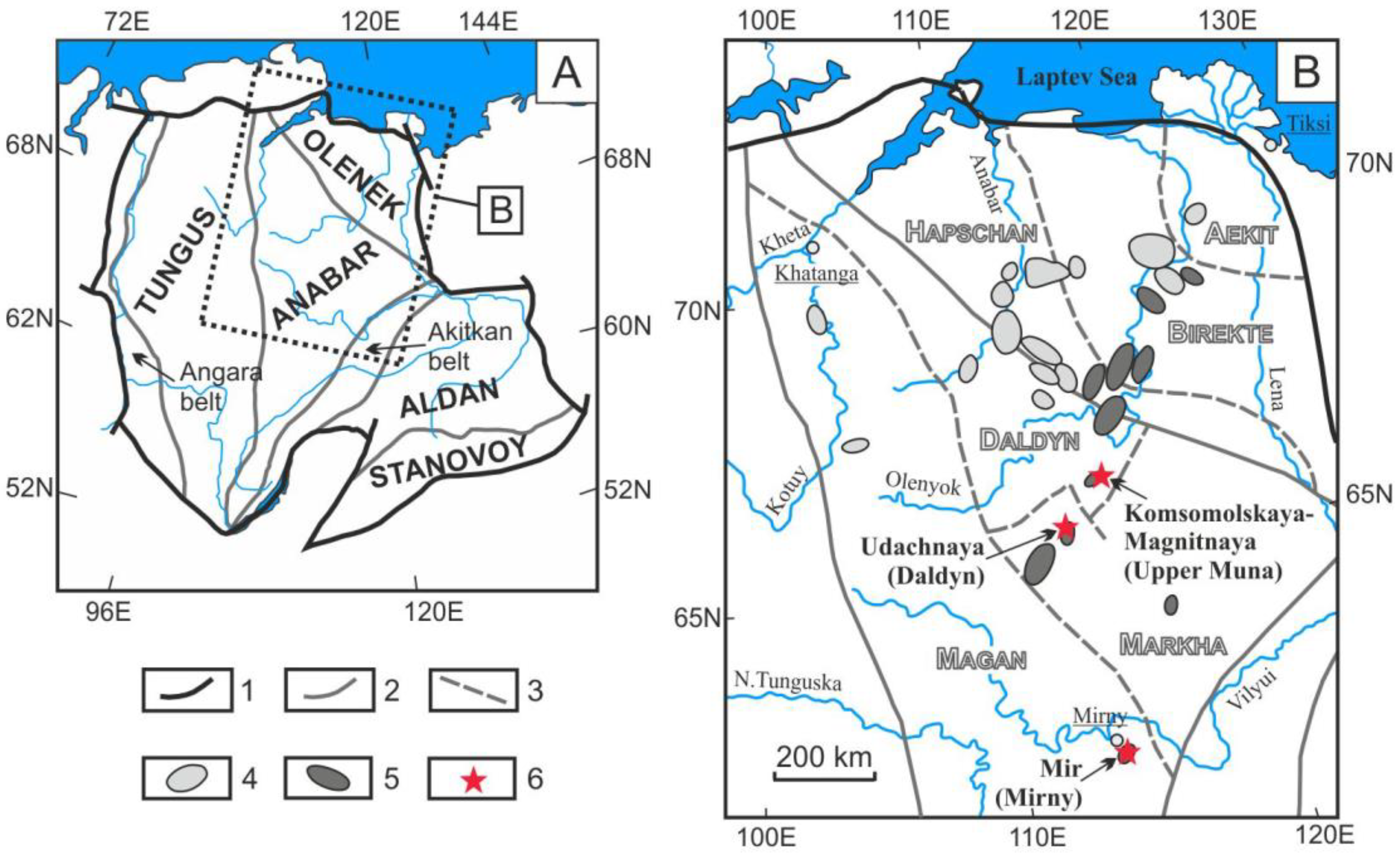
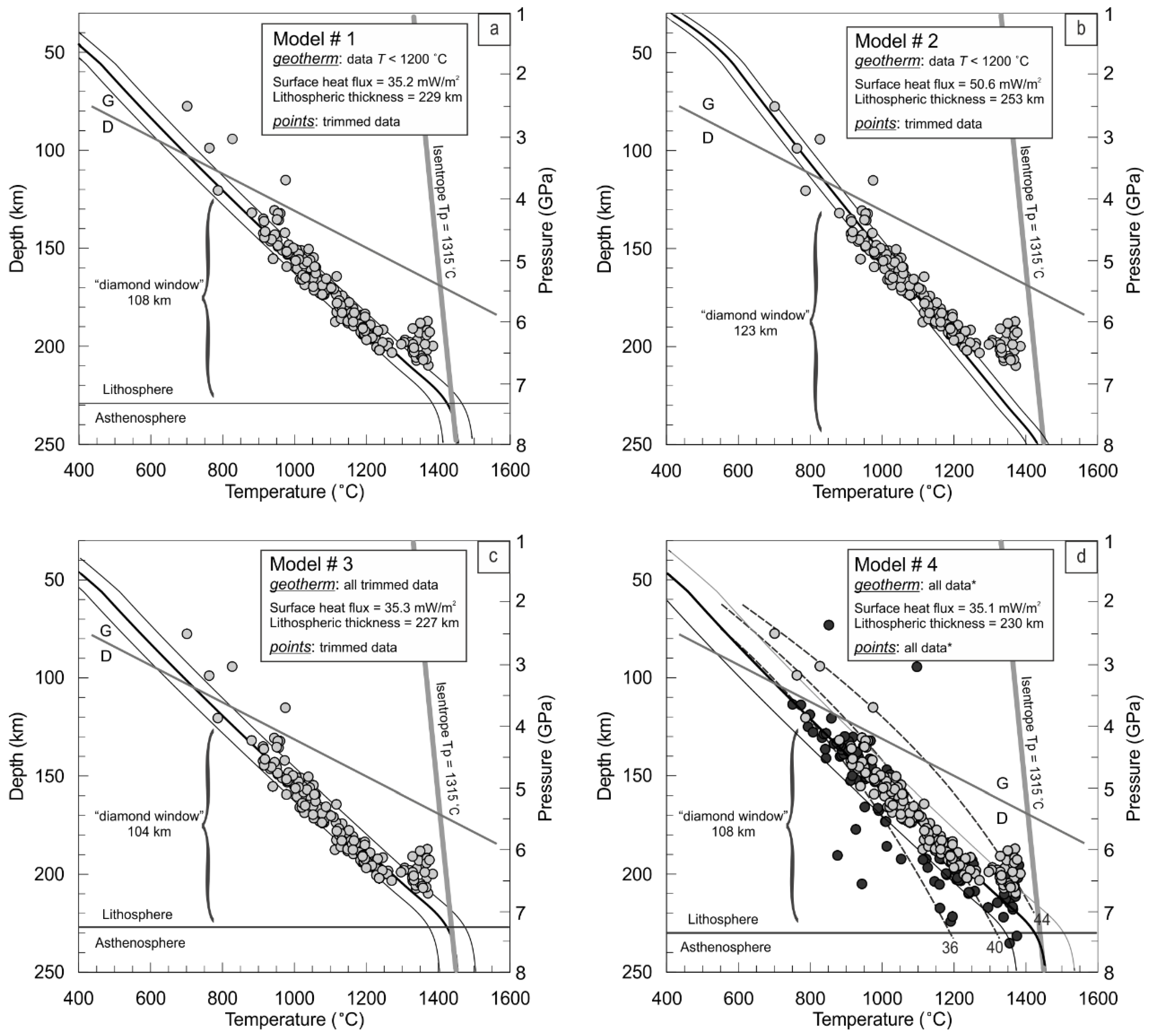
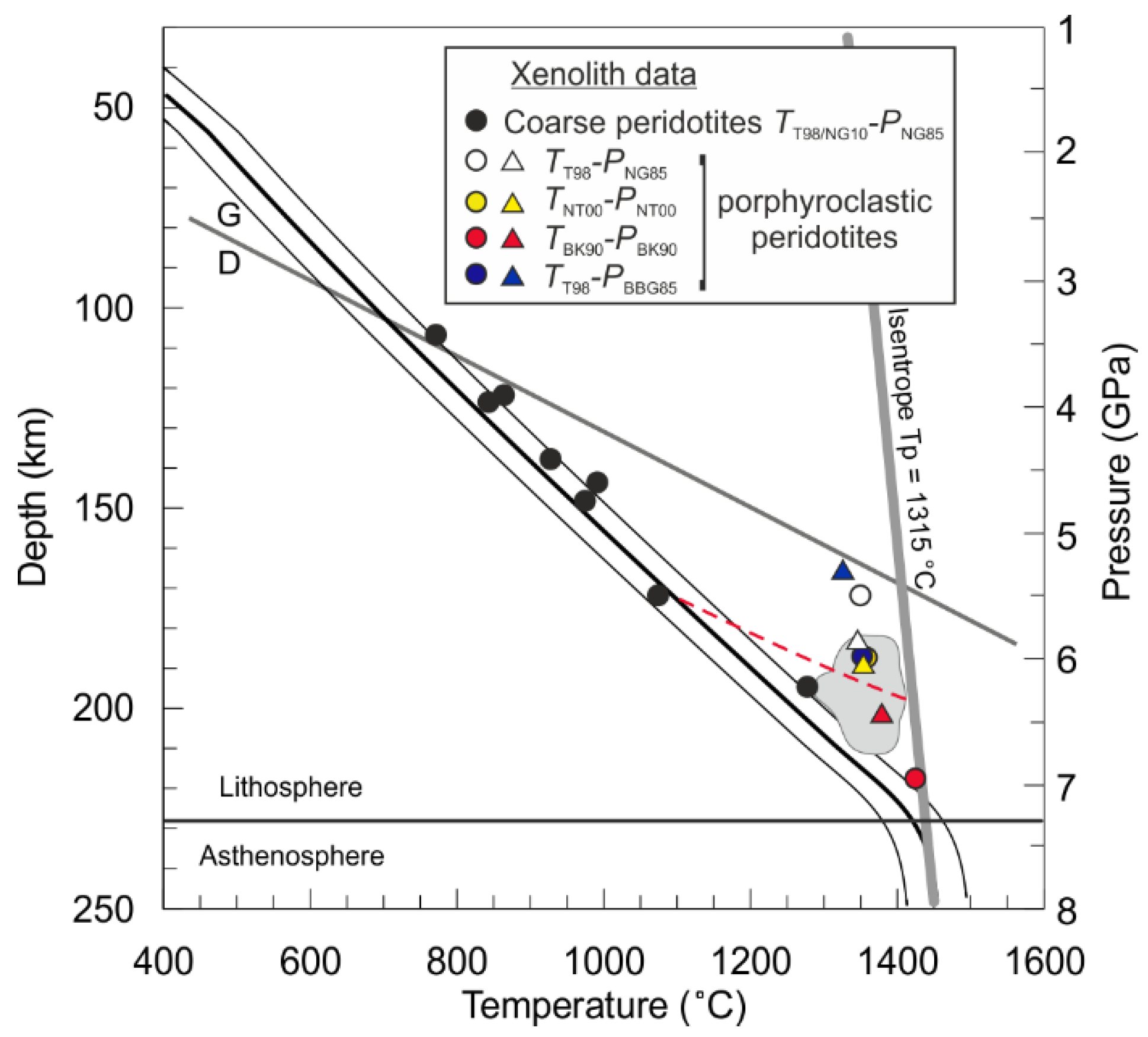
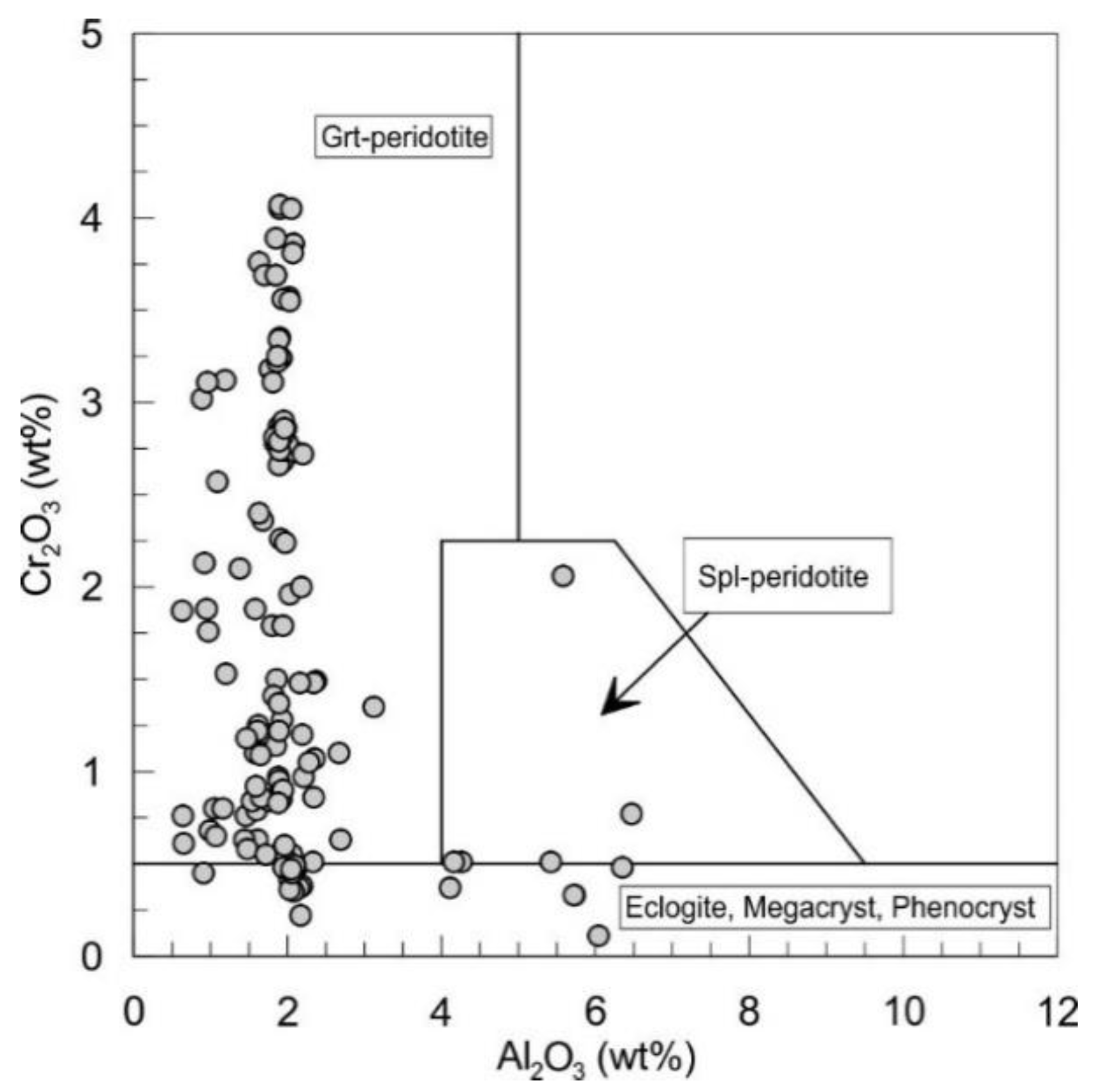

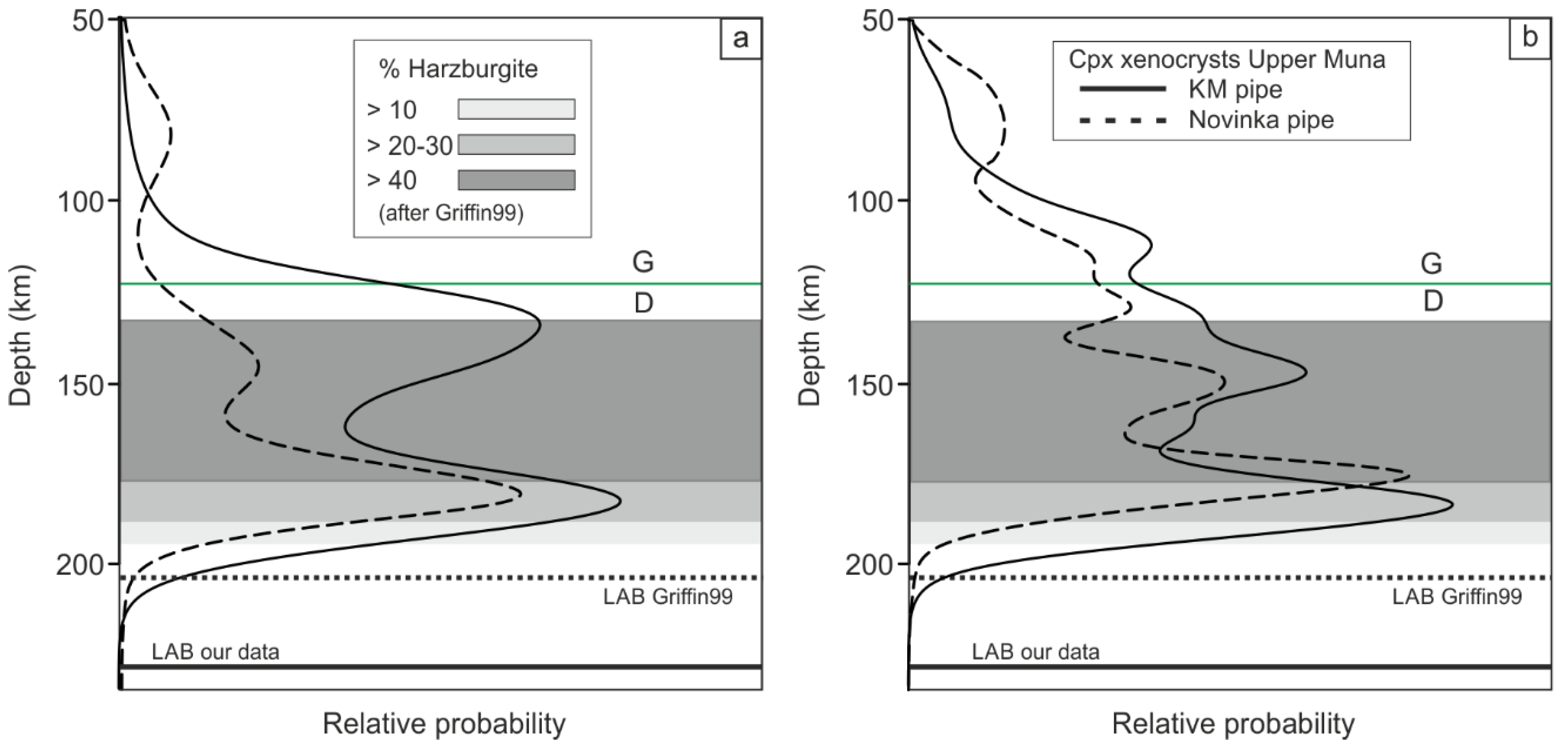
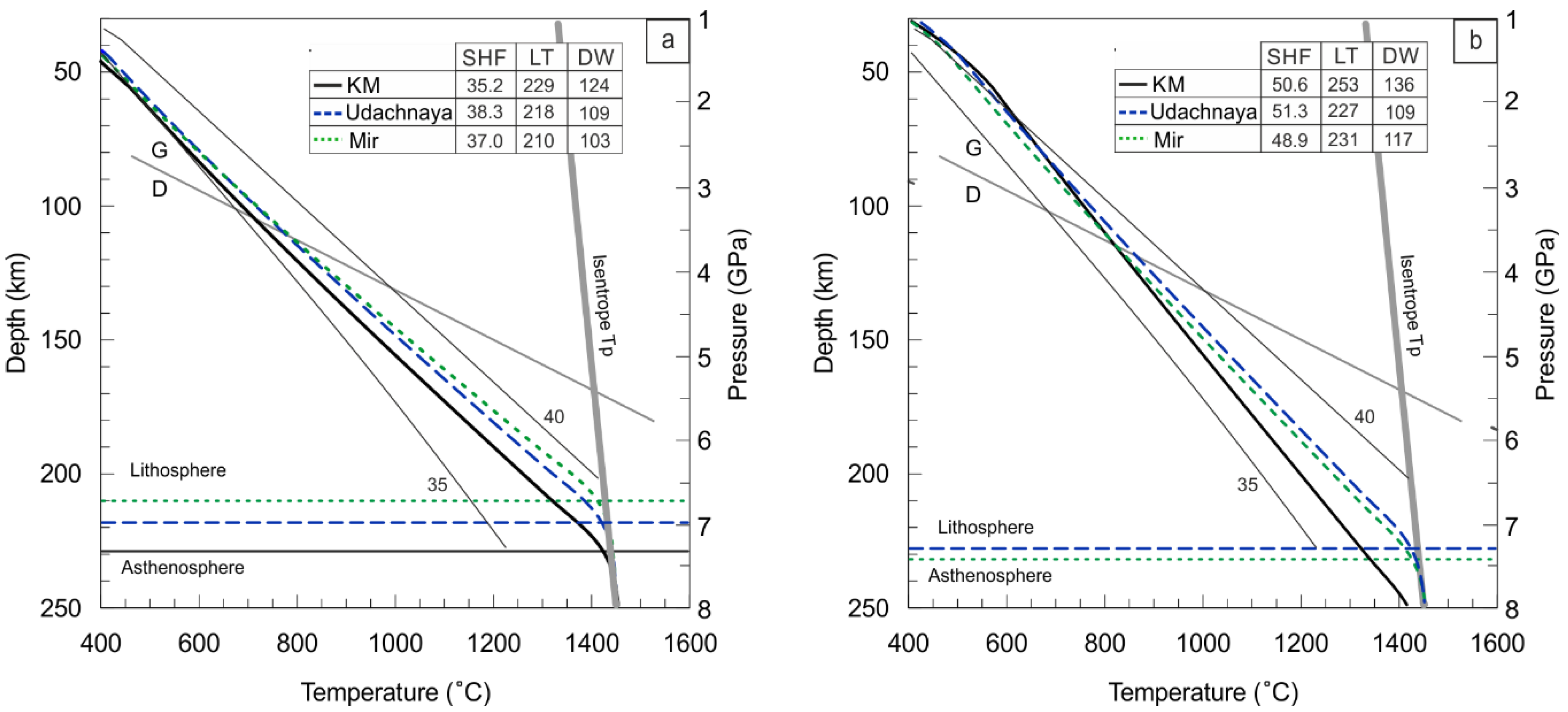
| Locality | Model | Comments | Input | Output | |||||
|---|---|---|---|---|---|---|---|---|---|
| HUCRUST 1 (µW/m3) | HLCRUST 1 (µW/m3) | TUCRUST 2 (km) | TLCRUST 2 (km) | Misfit 3 (°C) | LITH.B.L.4 (km) | SURF. HFLUX 5 (mW/m2) | |||
| KM | 1 | Trimmed P-T data, T < 1200 °C | 0.76 | 0.076 | 23 | 33 | 41 | 229 | 35.2 |
| KM | 2 | Trimmed P-T data, T < 1200 °C | 1.12 | 0.4 | 23 | 33 | 31 | 253 | 50.6 |
| KM | 3 | All trimmed P-T data | 0.76 | 0.076 | 23 | 33 | 50 | 227 | 35.3 |
| KM | 4 | All P-T points | 0.76 | 0.076 | 23 | 33 | 80 | 230 | 35.1 |
| Novinka * | [23] | 225 * | 34.1 * | ||||||
| Udachnaya | 1 | 0.76 | 0.076 | 28 | 16 | 96 | 218 | 38.3 | |
| Udachnaya | 2 | 1.12 | 0.4 | 28 | 16 | 108 | 227 | 51.3 | |
| Udachnaya | [6] | 1.12 | 0.4 | 40 | 10 | 242 * | 58.6 * | ||
| Mir | 1 | 0.76 | 0.076 | 25 | 18 | 101 | 210 | 37.0 | |
| Mir | 2 | 1.12 | 0.4 | 25 | 18 | 81 | 231 | 48.9 | |
© 2020 by the authors. Licensee MDPI, Basel, Switzerland. This article is an open access article distributed under the terms and conditions of the Creative Commons Attribution (CC BY) license (http://creativecommons.org/licenses/by/4.0/).
Share and Cite
Dymshits, A.M.; Sharygin, I.S.; Malkovets, V.G.; Yakovlev, I.V.; Gibsher, A.A.; Alifirova, T.A.; Vorobei, S.S.; Potapov, S.V.; Garanin, V.K. Thermal State, Thickness, and Composition of the Lithospheric Mantle beneath the Upper Muna Kimberlite Field (Siberian Craton) Constrained by Clinopyroxene Xenocrysts and Comparison with Daldyn and Mirny Fields. Minerals 2020, 10, 549. https://doi.org/10.3390/min10060549
Dymshits AM, Sharygin IS, Malkovets VG, Yakovlev IV, Gibsher AA, Alifirova TA, Vorobei SS, Potapov SV, Garanin VK. Thermal State, Thickness, and Composition of the Lithospheric Mantle beneath the Upper Muna Kimberlite Field (Siberian Craton) Constrained by Clinopyroxene Xenocrysts and Comparison with Daldyn and Mirny Fields. Minerals. 2020; 10(6):549. https://doi.org/10.3390/min10060549
Chicago/Turabian StyleDymshits, Anna M., Igor S. Sharygin, Vladimir G. Malkovets, Igor V. Yakovlev, Anastasia A. Gibsher, Taisia A. Alifirova, Sofya S. Vorobei, Sergey V. Potapov, and Viktor K. Garanin. 2020. "Thermal State, Thickness, and Composition of the Lithospheric Mantle beneath the Upper Muna Kimberlite Field (Siberian Craton) Constrained by Clinopyroxene Xenocrysts and Comparison with Daldyn and Mirny Fields" Minerals 10, no. 6: 549. https://doi.org/10.3390/min10060549
APA StyleDymshits, A. M., Sharygin, I. S., Malkovets, V. G., Yakovlev, I. V., Gibsher, A. A., Alifirova, T. A., Vorobei, S. S., Potapov, S. V., & Garanin, V. K. (2020). Thermal State, Thickness, and Composition of the Lithospheric Mantle beneath the Upper Muna Kimberlite Field (Siberian Craton) Constrained by Clinopyroxene Xenocrysts and Comparison with Daldyn and Mirny Fields. Minerals, 10(6), 549. https://doi.org/10.3390/min10060549






